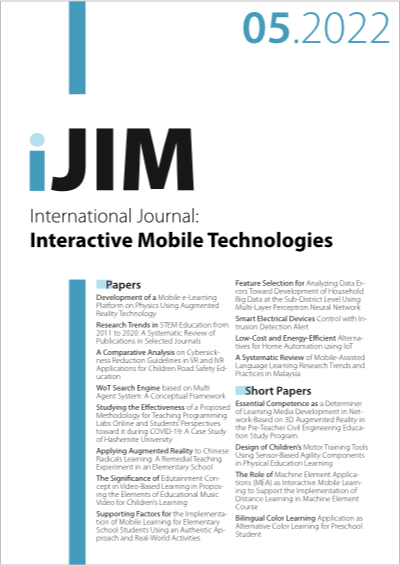A Comparative Analysis on Cybersickness Reduction Guidelines in VR and IVR Applications for Children Road Safety Education
DOI:
https://doi.org/10.3991/ijim.v16i05.26359Keywords:
Virtual Reality, Immersive Virtual Reality, Mobile HMD, Tethered HMD, Cybersickness, Simulator Sickness, Cybersickness Reduction Guidelines.Abstract
Nowadays, developing Virtual Reality (VR) and Immersive Virtual Reality (IVR) application is one of the alternative support tools used to support children in learning road safety education. At early stage of VR/IVR application development, cybersickness was one of the main concerns that occur in both non-immersive and immersive environment that include both VR platforms which are Mobile and Tethered. This is because it involves inconsistencies between visual and physical movement in the virtual environment. Thus, the primary concern of this study is to explore and identify appropriate design guidelines in reducing cyber and simulator sickness in developing VR/IVR application for both platforms which employed in previous research. In accordance, 14 studies have been selected for review in a comparative analysis. The findings of this study discuss the appropriate cybersickness reduction design guidelines and principle that applicable and beneficial in the development process of the VR/IVR application and respectively reducing the cybersickness effect
Downloads
Published
2022-03-08
How to Cite
Yahaya, N. S., Mutalib, A. A., & Abdul Salam, S. N. (2022). A Comparative Analysis on Cybersickness Reduction Guidelines in VR and IVR Applications for Children Road Safety Education. International Journal of Interactive Mobile Technologies (iJIM), 16(05), pp. 33–48. https://doi.org/10.3991/ijim.v16i05.26359
Issue
Section
Papers
License
Copyright (c) 2022 Nur Sauri Yahaya, Ariffin Abdul Mutalib, Sobihatun Nur Abdul Salam

This work is licensed under a Creative Commons Attribution 4.0 International License.


